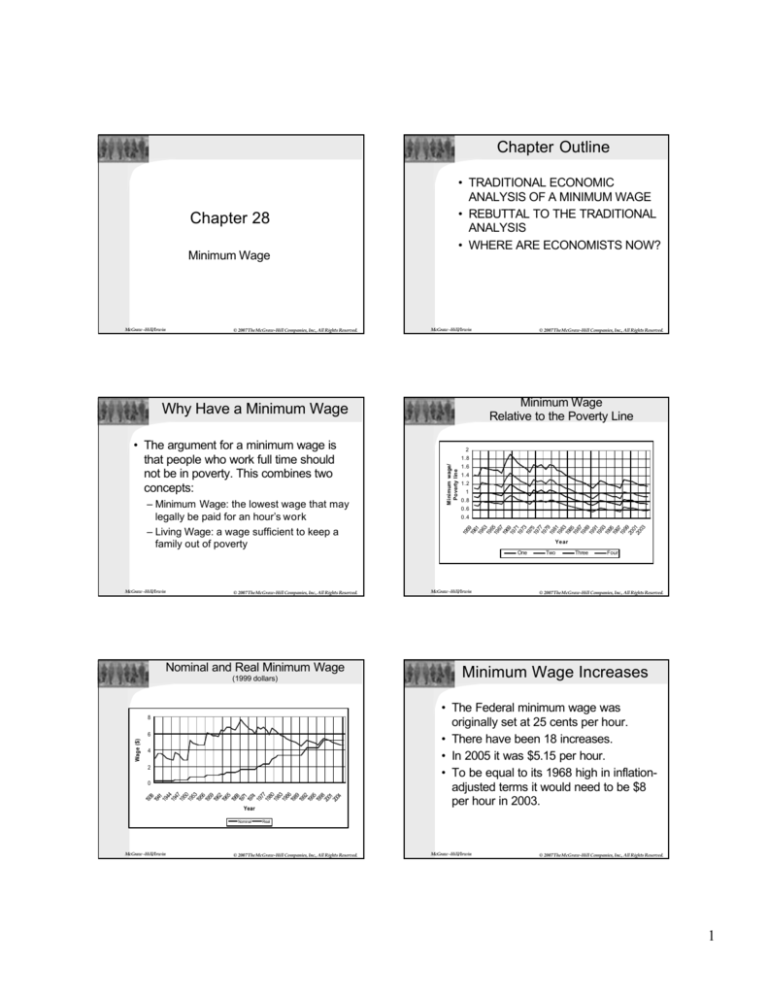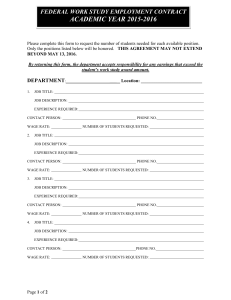
Chapter Outline
Chapter 28
Minimum Wage
McGraw -Hill/Irwin
© 2007 The McGraw-Hill Companies, Inc., All Rights Reserved.
• TRADITIONAL ECONOMIC
ANALYSIS OF A MINIMUM WAGE
• REBUTTAL TO THE TRADITIONAL
ANALYSIS
• WHERE ARE ECONOMISTS NOW?
McGraw -Hill/Irwin
Minimum Wage
Relative to the Poverty Line
Why Have a Minimum Wage
Minimum wage/
Poverty line
– Minimum Wage: the lowest wage that may
legally be paid for an hour’s work
– Living Wage: a wage sufficient to keep a
family out of poverty
2
1.8
1.6
1.4
1.2
1
0.8
0.6
0.4
19
5
19 9
6
19 1
63
19
6
19 5
67
19
69
19
7
19 1
73
19
75
19
7
19 7
79
19
8
19 1
83
19
85
19
8
19 7
89
19
9
19 1
93
19
95
19
9
19 7
99
20
0
20 1
03
• The argument for a minimum wage is
that people who work full time should
not be in poverty. This combines two
concepts:
© 2007 The McGraw-Hill Companies, Inc., All Rights Reserved.
Year
One
McGraw -Hill/Irwin
© 2007 The McGraw-Hill Companies, Inc., All Rights Reserved.
Nominal and Real Minimum Wage
(1999 dollars)
8
Wage ($)
6
4
2
19
38
19
41
19
44
19
47
19
50
19
53
19
56
19
59
19
62
19
65
19
68
19
71
19
74
19
77
19
80
19
83
19
86
19
89
19
92
19
95
19
98
20
01
20
04
0
Year
Nominal
McGraw -Hill/Irwin
McGraw -Hill/Irwin
Two
Three
Four
© 2007 The McGraw-Hill Companies, Inc., All Rights Reserved.
Minimum Wage Increases
• The Federal minimum wage was
originally set at 25 cents per hour.
• There have been 18 increases.
• In 2005 it was $5.15 per hour.
• To be equal to its 1968 high in inflationadjusted terms it would need to be $8
per hour in 2003.
Real
© 2007 The McGraw-Hill Companies, Inc., All Rights Reserved.
McGraw -Hill/Irwin
© 2007 The McGraw-Hill Companies, Inc., All Rights Reserved.
1
Minimum Wages
in States and Cities
States
Cities
New York
Delaware
Florida
Hawaii
Maine
Illinois
District of Columbia
Rhode Island
Massachusetts
California
Vermont
Connecticut
Oregon
Washington
Baltimore, MD
Boston, MA
Chicago, IL
Cleveland, OH
Denver, CO
Detroit, MI
Los Angeles, CA
Minneapolis, MN
San Antonio, TX
San Francisco, CA
McGraw -Hill/Irwin
The Labor Market without a Minimum
Wage
•
W
A
W*
C
B
0
© 2007 The McGraw-Hill Companies, Inc., All Rights Reserved.
L*
McGraw -Hill/Irwin
– The company must pay the market wage to
attract workers.
– Paying below the market wage is not in its
interests because such a wage would not
attract sufficient workers to the company.
McGraw -Hill/Irwin
© 2007 The McGraw-Hill Companies, Inc., All Rights Reserved.
• The gain to the workers who keep their
jobs is less than the loss to the losers
who
– lose their jobs and
– are firms who have to pay higher wages.
McGraw -Hill/Irwin
(continued)
– small businesses more than larger firms.
– minorities more than whites.
• A majority of minimum wage workers are
young adults who are not supporting families.
An increase in the minimum wage is an
inefficient mechanism for helping poor
working families.
McGraw -Hill/Irwin
© 2007 The McGraw-Hill Companies, Inc., All Rights Reserved.
© 2007 The McGraw-Hill Companies, Inc., All Rights Reserved.
The EITC Alternative
to the Minimum Wage
The Case Against
• An increase in the minimum wage by 10%
decreases the number of jobs held by teens
by 1% to 3%.
• A minimum wage increase negatively affects
© 2007 The McGraw-Hill Companies, Inc., All Rights Reserved.
What’s Wrong with the
Minimum Wage
Minimum Wage Relevance
• A minimum wage is only relevant if it is
above the market wage.
• A minimum wage below the market
wage is irrelevant.
Value to the firms:
• 0ACL*
Supply
• Firms pay workers:
• OW*CL*
• The opportunity cost to workers:
• OBCL*
• Surplus to firms:
• W*AC
Demand • Surplus to workers:
Labor • BW*C
• The earned income tax credit (EITC)
– is a targeted tax credit to the working poor.
– was, in 2004, as much as $4,140 for a
working poor family with two children.
– 70% of benefits go to households in
poverty
– 70% of minimum wage benefits go to
households not in poverty
McGraw -Hill/Irwin
© 2007 The McGraw-Hill Companies, Inc., All Rights Reserved.
2
The Rebuttals to the Traditional
Analysis
• The Macroeconomic Argument
– The money that is transferred from employers to
employees in more likely to be spent than saved
thereby increasing GDP.
• The Work Effort Argument
– People who are paid more may work harder than
people who are paid less. This may return some of
the increased wage paid by employers back to
them in terms of increased productivity.
• The Inelasticity of Labor Demand Argument
Where are Economists Now
• Economists have long been against the
minimum wage and for the EITC.
• Card and Kruger challenged many of the
long-held conclusions in the 1990s with
research verifying the Inelasticity Argument.
• For most labor economists, subsequent
research has re-verified the original pro- EITC,
anti-minimum wage argument.
– If the demand for labor is inelastic then there is
less of a loss in employment and a smaller
deadweight loss.
McGraw -Hill/Irwin
© 2007 The McGraw-Hill Companies, Inc., All Rights Reserved.
Kicking it Up a Notch: Demonstrating the
Case Against the Minimum Wage
•
W
•
Supply
A
E
W min
W*
•
C
•
F
B
•
Demand
0 Lmin L* LS
McGraw -Hill/Irwin
Labor
•
Value to the firms:
• 0AEL min
Firms pay workers:
• 0W minELmin
The opportunity cost to workers:
• 0BFLmin
Surplus to firms:
• W minAE
Surplus to workers:
• BW minEF
Unemployed workers
McGraw -Hill/Irwin
Demonstrating the Inelasticity Argument
W
Supply
E
W min
W*
F
C
B
Low level of DWL
Demand
0
• Who had jobs
• L*-Lmin
• Who are now looking
• LS-L*
© 2007 The McGraw-Hill Companies, Inc., All Rights Reserved.
© 2007 The McGraw-Hill Companies, Inc., All Rights Reserved.
LminL*
Labor
Small number of displaced workers
McGraw -Hill/Irwin
© 2007 The McGraw-Hill Companies, Inc., All Rights Reserved.
3







